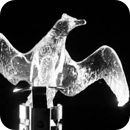Double Network Gel: Tough Hydrogel
Living organs work with fantastic functions in soft and wet gel-like states, except for hard compositions such as bone and tooth. Thus, hydrogels attract considerable attention as excellent wet materials, suitable for fabricating artificial organs for medical treatments. However, conventional hydrogels are too brittle to be employed in such applications. To address this problem, our laboratory succeeded in synthesizing tough double network hydrogels (DN gels) by combining rigid strong polyelectrolyte gels (the first network) with flexible neutral polymer gels (the second network).

Strength and toughening mechanism of DN gels
DN gels are as strong as rubber, and their compressive fracture stress is about 10–60 MPa (100–600 kgf/cm2), which is approximately hundred times stronger than single network gels (0.3–0.6 MPa). In addition, some types of DN gels also show flexibility, with tensile fracture strains reaching 30.
These high mechanical properties of DN gels arise from the reciprocity of two networks, which suppress the progression of cracks. When force is applied to DN gels, the rigid and brittle first network breaks down. For single network gels, microcracks can spread and cause a breakdown of the network , while for DN gels, the existence of the soft second network can connect the fragments of the first network, thereby suppressing the scale-up of microcracks. Therefore, large amounts of microcracks are in co-existence because of the distribution of stress, and large amounts of energy are dissipated in this process.

DN gels from natural materials
We have also developed tough hydrogels that were constructed completely from natural materials. Bacterial cellulose gels (BC gels), produced by Acetobacter xylinum, show high tensile fracture stress, but cannot hold enough water within them. In contrast, gelatin gels derived from animals can hold a sufficient amount of water, but they possess poor mechanical properties. We have succeeded in synthesizing BC/gelatin DN hydrogels having excellent mechanical properties by combining these two kinds of gel in order to compensate for each of their individual weaknesses.
Applications in regeneration medicine
We are trying to apply DN gels to regeneration medicine in co-operation with Prof. Yasuda’s group (Graduate School of Medicine, Hokkaido University). Articular cartilages play very important roles such as cushioning when we perform exercises. Until now, it was believed that once an articular cartilage is broken, it would never fully regenerate. Hence, it has been difficult to repair a broken cartilage adequately. However, we succeeded in regenerating a cartilage by embedding a biocompatible DN gel in the defect of rabbit cartilage for four weeks. This is the world’s first case of successful cartilage regeneration!
Freely shapeable DN gels

Compared with common hydrogels, DN gels possess higher mechanical properties. However, there are some problems with regard to their application. The largest problem is that it is difficult to synthesize DN gels in free shape because of the poor mechanical strength of the first network gel. Apart from this issue, it is important to be able to shape gels freely for application as artificial cartilage. Recently, we succeeded in synthesizing freely shapeable DN gels by two methods: by synthesizing DN gels from a particle first network gel or by using a poly(vinyl alcohol) hydrogel mold.
References
Gong, J. P.; Katsuyama, Y.; Kurokawa, T.; Osada, Y. Adv. Mater. 2003, 15, 1155.
Na, Y.-H.; Tanaka, Y.; Kurokawa, T.; Furukawa, H.; Sumiyoshi, T.; Gong, J. P.; Osada, Y. Macromolecules 2006, 39, 641.
Tanaka, Y.; Kawauchi, Y.; Kurokawa, T.; Furukawa, H; Okajima, T.; Gong, J. P. Macromol. Rapid Commun. 2008, 29, 1514.
Yasuda, K.; Kitamura, N.; Gong, J. P.; Arakaki, K.; Kwon, H. J.; Onodera, S.; Chen, Y. M.; Kurokawa, T.; Kanaya, F.; Ohmiya, Y.; Osada, Y. Macromol. Biosci., 2009, 9, 307.
Related News
-
Tian-san introduced his research to high school students at 明日(Akebi)中等教育学校 in Noboribetsu as a program “Science Dialogue” of JSPS!
- Event
-
The Supplementary Cover Art for the manuscript written by Dr. Martin Frauenlob is now published in ACS Macro Letters!
- Awards & Publications
-
[Seeds] Flexible and Strong Gel
- Research

